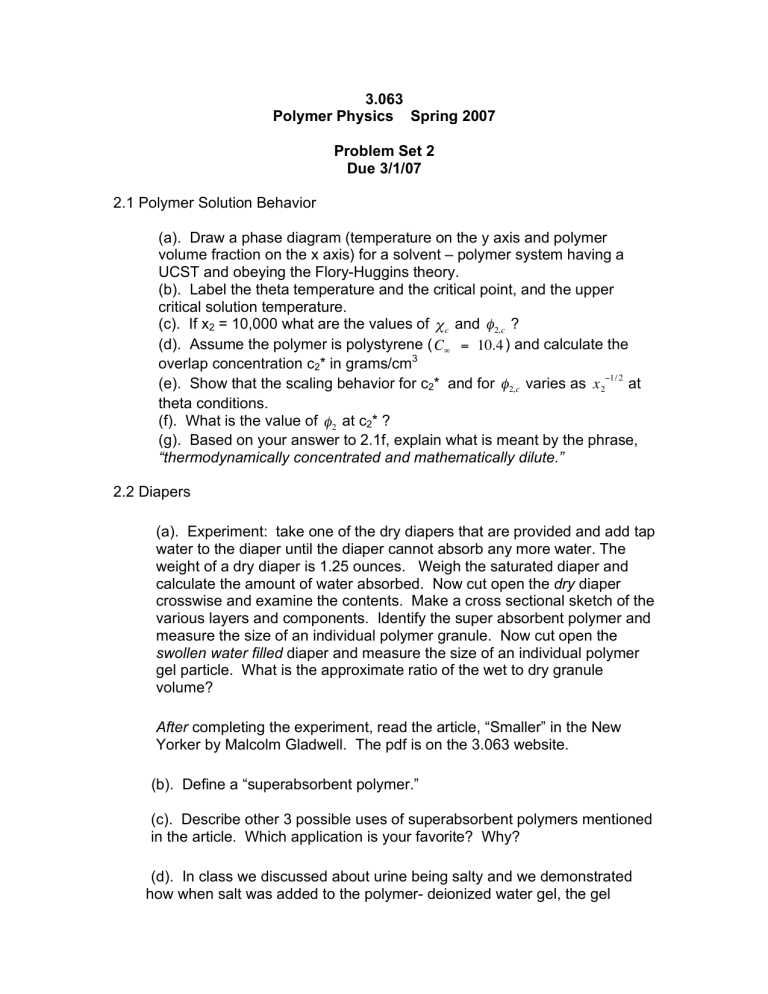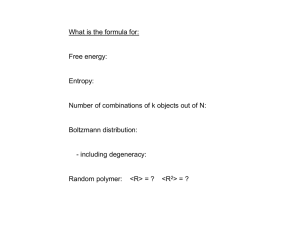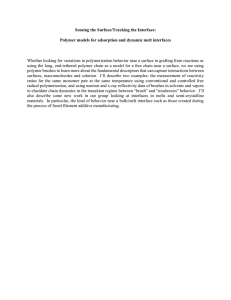3.063 Polymer Physics Spring 2007 Problem Set 2 Due 3/1/07

3.063
Polymer Physics Spring 2007
Problem Set 2
Due 3/1/07
2.1 Polymer Solution Behavior
(a). Draw a phase diagram (temperature on the y axis and polymer volume fraction on the x axis) for a solvent – polymer system having a
UCST and obeying the Flory-Huggins theory.
(b). Label the theta temperature and the critical point, and the upper critical solution temperature.
(c). If x
2
= 10,000 what are the values of
" c and
"
2, c
?
(d). Assume the polymer is polystyrene ( overlap concentration c
2
* in grams/cm 3
C
"
= 10.4
) and calculate the
!
* and for
"
2, c varies as x
2
" 1/ 2 at theta conditions.
(f). What is the value of
"
2 at c
2
* ?
(g). Based on your answer to 2.1f, explain what is meant by the phrase,
“thermodynamically concentrated and mathematically dilute.”
2.2 Diapers !
(a). Experiment: take one of the dry diapers that are provided and add tap water to the diaper until the diaper cannot absorb any more water. The weight of a dry diaper is 1.25 ounces. Weigh the saturated diaper and calculate the amount of water absorbed. Now cut open the dry diaper crosswise and examine the contents. Make a cross sectional sketch of the various layers and components. Identify the super absorbent polymer and measure the size of an individual polymer granule. Now cut open the swollen water filled diaper and measure the size of an individual polymer gel particle. What is the approximate ratio of the wet to dry granule volume?
After completing the experiment, read the article, “Smaller” in the New
Yorker by Malcolm Gladwell. The pdf is on the 3.063 website.
(b). Define a “superabsorbent polymer.”
(c). Describe other 3 possible uses of superabsorbent polymers mentioned in the article. Which application is your favorite? Why?
(d). In class we discussed about urine being salty and we demonstrated how when salt was added to the polymer- deionized water gel, the gel
disappeared and the solution became much less viscous. How do diaper makers contend with salty urine?
(e). Gladwell argues that smaller is better, not only for transitors (Moore’s
Law) but for diapers. He ignores landfill disposal issues. Make a list of the attributes of a modern disposable diaper that would contribute to decreasing landfill volume. On the other hand, cloth diapers are still favored by some parents for various reasons, including the idea that cloth diapers cause less pollution of the environment. Make a list of issues that would have to be considered in determining whether “cloth” or “disposable” diapers are better for the environment.
2.3
(a). The theta condition for polymers corresponds to an ideal state where flexible polymer chains act like random walks and solution thermodynamics becomes simplified. Show starting from the Flory-
Huggins expression for the chemical potential difference of the solvent in the polymer solution and that of the pure solvent reference state, that at theta conditions, the polymer solution becomes an “ideal solution.”
µ
1
" µ
1
0
= RT
+
-
,
"
#
2 x
2
+
%
'
&
$ "
1
2
(
* #
)
2
2
.
0
/
!
!
" c
2
= RT
+
-
,
1
M n
+
% 1
'
& 2
# $
(
*
)
V
1 x
M n
2
2
2 c
2
(b). Furthermore, show that the osmotic pressure of a polymer solution obeys an ideal gas law at theta conditions where the chain molecules act like an ideal gas.
.
0
/


